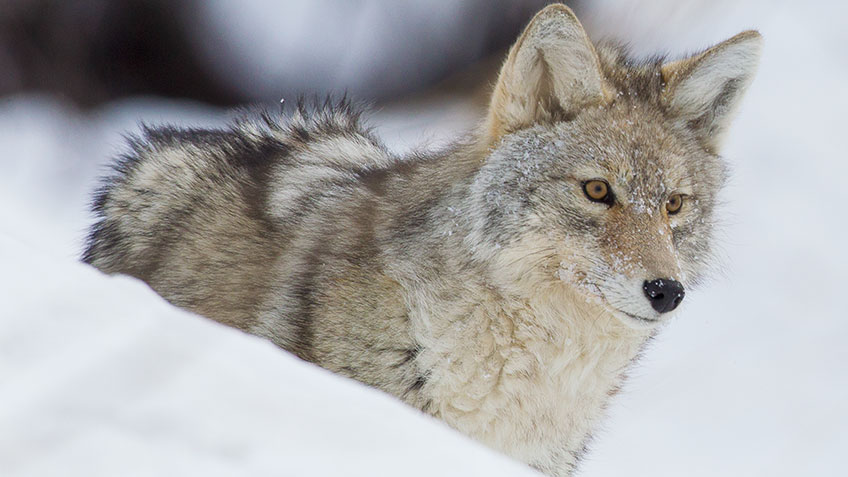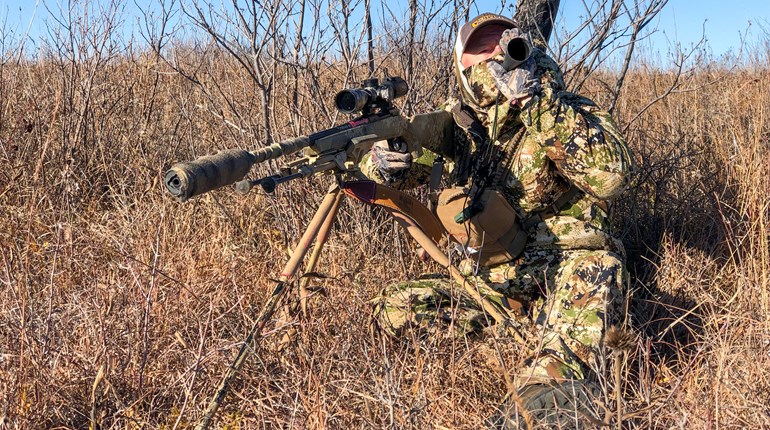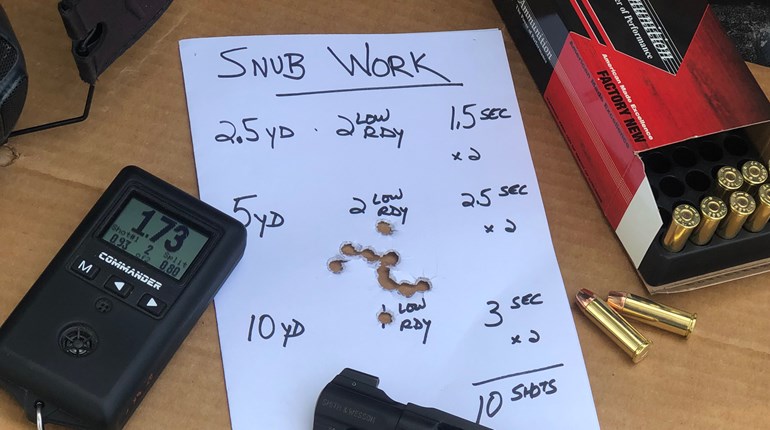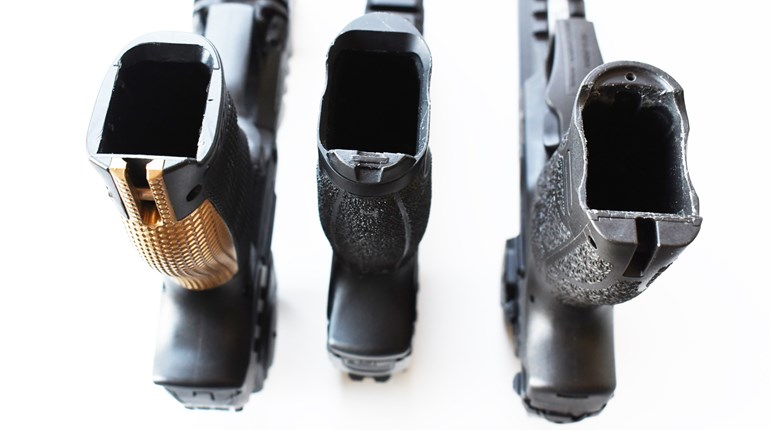
“Easy,” I whispered with a hint of nervousness in my hushed tone. I was eyeing a coyote coming to my calls as it prepared to cross into easy shooting distance. My verbal directive was meant for two recipients. First and foremost was my son, Cole, at my side eagerly clutching his birthday-present AR, nervously anticipating his first shot at a coyote. The second and nearly as significant recipient was the latest addition to the Kayser family, Sage, a yearling border collie. I certainly hoped to get Cole a shot. I wanted the situation to play out safely, but every coyote called in was also a possible training opportunity for the young dog scanning the landscape.
Sage’s eyes locked on the coyote as it crossed a particularly snowy stretch of ground, making it stand out like Darth Vader in a squad of Stormtroopers. Unfortunately for Cole, the coyote was swinging my way, and with its widening course toward a series of coulees even a shot for me was beginning to look doubtful.
Experience is the best teacher, so I softly instructed Sage to “get ’em.”
With laser focus that would leave even Lassie envious, Sage kicked up a flurry of snow and headed straight for the coyote. In seconds the coyote braked hard, assessed quickly and locked on to Sage with charged determination. It either thought Sage was the maker of the howls it heard earlier or it simply had a “Fight Club” attitude. Things were about to get heady as both canines were bent on a meeting.

Had I known then what I knew now about coyote distraction via a dog, I would have let Cole make a big move to make the shot. But at the moment, for the sake of safety and opportunity, I resisted and shifted my Bergara slightly to line up on the closing coyote for a straight-on shot. The coyote collapsed as the V-Max slammed into its chest, and Sage circled it a few bounds later with a victory lap.
Cole and I arrived promptly to share our kudos with the bubbling border collie. You could see it in her face—engaging coyotes was as cool as herding our mule to the farthest reaches of our pasture. After that successful setup I knew that even when my kids couldn’t tag along on a coyote hunt I’d always have a partner … a furry partner at that.
Coyote Dogs Through History
There’s no denying dogs, wolves and coyotes have a common ancestor somewhere back in the family photo album. Who that Uncle Scooby was has come under question in recent years with the use of DNA analysis. After samples from wolves and wild canids around the globe have been studied, it appears as if the common ancestor isn’t the gray wolf at all—it’s not the Blue Buffalo dog food commercial stereotype. Instead, it appears as if the common factor was likely a wolf-like ancestor common to both species that died off eons ago. Regardless of where the family tree forked, new genetic evidence suggests dog domestication likely occurred more than 30,000 years ago, much earlier than originally proposed. It’s hypothesized that dog ancestors began following humans and domesticated themselves, or that primitive man caught dog ancestors as pups to tame. The rest is history … really. Dogs left an easy-to-read archaeological record, and have been used throughout history for a variety of hunting duties.
Coyote hunting with dogs rose from early fur gatherers and livestock producers in the New World. The fur gatherers hoped to make a buck; the livestock moguls simply wished to eradicate lamb- and calf-killers from their lands. From that rose the pursuit of coyotes with greyhounds and greyhound crosses.
Called coyote coursing, hunters use the greyhounds to chase down and kill a coyote. Dog handlers drive around searching for a wandering coyote. Once they spot one they release the greyhounds waiting anxiously in a dog box on the bed of a truck. A few run on scent, but once the greyhounds acquire a visual the chase is on. Coyote coursing doesn’t have the charm depicted in a 17th-century English painting portraying horseback fox hunting with hounds, but the premise is similar.
Trending in the coyote-hunting world is “tolling.” Variations of the concept likely date back to our cave-loving descendants who somehow survived without a smartphone and Google. Whether they used their domesticated canines to chase off marauding wolves or lure them closer to acquire a new sport coat, dogs served as a lure to close the distance for a kill. In modern times, names like Murphy Love, Merv Griswold and Levi Johnson have spurred interest in tolling, particularly utilizing mountain curs to toll coyotes into easy shooting range. Much of the tolling hunting takes place in the warm-weather months when coyote pairs determinedly protect pups and den sites. Hunters scout for likely denning areas then use calls to persuade coyotes to show themselves. Once the dogs get a visual they tease and torment the coyotes to follow them back to their owners waiting with a centerfire closing.
Reading about and watching those unbelievable coyote encounters on the screen seized my attention like a bacon-flavored dog treat does to a dog. Discussions with local wildlife damage specialists and predator-control officials who relied on dogs further spiked my interest in having a canine as a coyote-hunting partner. Not only would a dog serve as a possible boost to my coyote success, it would be the perfect partner. I wouldn’t have to wait in the early-morning hours on a dog that was running late or stress about a dog sharing my hunting locations with others. The only negatives: A dog wouldn’t share fuel expenses, and I might have to scoop some poop on occasion. Fortunately I’ve never been tasked with that chore while hunting with humans … not yet, anyway.
There was the inevitable family discussion about whether we should add another member to the Kayser crew that already included two kids and a heavy dose of associated activities. Then there was a contentious debate on what breed to invite to our clan. I knew the mountain cur was the go-to breed. On the other hand, I’d heard of several coyote doggers putting herding dogs including blue heelers and border collies to work with success.
Since the dog would also serve as a family bonding tool, and we knew of several personable border collies owned by friends, a herding dog leaped to the top of the list. A classified ad soon led us to a remote Montana ranch on a dark and frigid February evening. With the help of my daughter, Katelyn, we picked out a personable pup living in snowy conditions underneath a dilapidated porch that sported the classic border collie look. After a family meeting it was decided she’d be called Sage.
Sage in Training
Training Sage began immediately with the basics that make any dog great. In addition to “sit, stay, down” and other commands, I also initiated a bonding routine. Instead of putting Sage in a kennel or leaving her at home while I ran errands, I took her everywhere—literally. She stayed in my office while I wrote, which lead to a major job rewiring computer connections below my desk. Beyond that, she sat with me on the front seat of the truck and on the back of the ATV to prepare her for long trips to backcountry locales. When the road ended she tromped along at my side, and when I could see her little legs tiring it was time to plop her in a backpack with only her head exposed. To this day she allows me to pack her when the terrain gets tough, typically in a high-elevation boulder field.
Her training quickly advanced with the help of pieces of hot dog as treats. Soon, I introduced her to firearms. There are volumes written on how to ensure your hunting dog doesn’t become gun-shy. My training was routinely basic: I first introduced her to air rifles, and after she seemed indifferent we fired a .22 in the distance, eventually moved closer then evolved to larger calibers. Today I have to scold her to leave or she’ll sit by my side and watch me sight-in a rifle.

As an avid shed-antler hunter, I was hoping she could serve double-duty, so I also began training Sage to find antlers. Although she never latched on to it like she did with coyotes, she’s my full-time hiking partner; now, whenever I see her sitting patiently I walk over to find her waiting beside a shimmering antler.
“Sit” and “stay” were easy, but training her for coyotes required some creative exercises. To get her in the mind-set that not all canines are to be met with a tail-wagging greeting, I utilized a reoccurring irritation: the neighbor’s dog. As a herding dog, Sage’s brain is programmed to pursue and direct other animals. She began to understand the safe space of home and made sure the other dog knew the boundaries of our homestead. Next up: It was time to take her coyote hunting.
Let’s Go Hunting, Dad
It took her several seasons to fully comprehend her coyote-hunting job description, but pursuing the neighbor’s dog put her in the mind-set to engage incoming coyotes. That led to the opening meeting, when I believe a lightbulb lit up in her head: I think he wants me to confront these coyotes, but if it looks like danger I’ll just head back to the guy with the gun.
Maybe Sage didn’t have those thoughts, but border collies are deemed the smartest of all breeds. I believe it was no coincidence that when a coyote she was confronting tipped over, it quickly reinforced her role on wintry outings.
Unlike many of the televised hunts incorporating coyote dogs, most of my coyote hunts take place with snow on the ground. That equals spooky coyotes that are worried more about survival than pup protection. Even so, what I’ve discovered is that young-of-the-year coyotes, especially sibling groups, and dominant adults, characteristically have an interest in another pooch. I can count on one hand the occasions where a coyote turned tail at the sight of Sage. Most advance, circle, or sit and stare as she puts on a bold front at their appearance.
My goal was never to have her get in fights with coyotes. In fact, most of my setups occur in the dimly lit hours of dawn and dusk. In that setting, I hoped the ghostly shadow of another canine, aka Sage, pacing on a ridge above me would instill confidence in coyotes that had already heard my coyote vocalizations. That hunch was correct, but canines just want to sniff the butts of other canines, as we see at a dog park. There’s little butt sniffing going on during our hunts, but there is plenty of curiosity. That soon shifts to prairie posturing. It’s the perfect recipe to get the upper hand on a cagey coyote.
Every setup begins with Sage staged off to my side. If a coyote arrives to my calls, there’s no need to command her to engage. With experience, she now warns me of approaching coyotes with a growl, sometimes before I even see them with the help of a binocular. As she’s gotten older she also tends to freelance a tad more. Instead of waiting for my command to “get ’em,” she advances on a coyote spontaneously. I’ve never seen her free-will spirit blow an opportunity. It’s typically the opposite.
One morning while sitting on a steep slope, the blur of coyote at less than 50 yards blindsided me. That coyote was followed by two others charging behind it. Sage sprung from my side thinking we were about to get overrun. In the melee I embarrassingly missed the first coyote, and it trotted away with a smug glance back at the bee-lining border collie. Despite Sage’s newfound uncertainty regarding my shooting skills, she followed the brash coyote into the maze of sagebrush. It took a stand, and the two locked up for a showdown. They had covered a spacious amount of ground, requiring me to range the shot just shy of 300 yards. Both held steadfast long enough for me to shift my Bergara and topple the coyote with a polymer-assisted projectile.
On another setup I admit to dozing off, but upon awakening it hit me: Sage was MIA! Movement to my left confirmed she didn’t join me for naptime. She was racing back and forth with a dogged coyote determined to lure her into a back-alley meeting. As they faced off on a distant ridge, I quickly repositioned and calculated the shot for 280 yards. Just as I was about to press the trigger, the coyote vaulted for Sage—and she knew it was time to head back to the man with the plan.
The coyote followed her but broke off halfway to circle downwind. That was a bad idea, because as soon as I found a pathway through the sagebrush and barbed wire I happily ended its search for future meals.
I won’t brag and tell you my coyote success has increased exponentially with Sage by my side. It hasn’t. If I shoot a coyote a weekend I feel like a lottery winner on the public lands I hunt. But despite not stacking up coyotes till they can be seen above my truck bed, the gratification I receive while shooting a coyote over a dog has exponentially increased my hunting satisfaction. Thanks, Sage!
Is Your Corgi Coyote-Ready?
Does this article make you think about putting your pooch into a coyote cage match? In brief, leave the lap dog at home and think responsibly if you decide to use a dog while coyote hunting.
Failing to choose the right dog, train it properly and hunt conscientiously with it could jeopardize the safety of your canine partner.
Any medium-sized dog will work for coyote tolling if it has a confrontational and bold character. Any dog that cowers behind your back won’t be much good other than to talk to on the ride home. Larger dogs also don’t tire as easily as a Pomeranian that could get carried away as easily as a Snickers bar. On the other hand, the Brontosaurus-like appearance of a St. Bernard could be too alarming to an approaching coyote.
Put proper training first. One of the best training tools in the world is a seasoned dog. Bird-dog handlers routinely let their young dogs accompany field veterans. Coyote dog enthusiast Levi Johnson was adding another cur to his team while I was on a recent hunt with him. He’ll let the newbie join the veteran coyote crew as soon as it completes basic training. I believe in that style of training, and I am in the market right now for a pup to train under Sage.
If you don’t have a coyote dog expert in your ZIP code start with a reserved approach. Whether you utilize training collars or rely on commands, make sure your dog reacts accordingly all the time. Let the dog tag along, and call in a coyote or two before letting it encounter a coyote up close. When you show the dog that the end goal is a dead coyote or two, and it reacts with glee, “Katie, bar the door.” You’ll be front row to the best coyote hunt of your life.
E.L.K. is A-OK for Coyote How-To
To learn more about tolling coyotes with dogs check out DVDs sold by E.L.K. of Gardiner, Mont. Among the company’s many products is its “Dogging Coyotes” DVD series (I and II, $14.99 each) and six more how-to films including “Coyote Tactics” and “Power Howling Coyotes.” Want an all-in-one kit? Check out the Yote Buster package that includes the company’s Yote Buster and Yote Squeaker calls, spare reeds and the “Coyote Tactics” DVD for $34.99. For more information, go to elkinc.com.
Rise of the 6.5's
There’s no shortage of coyote-killing cartridges on the market today. The .22-250 Rem. and .223 Rem. have accounted for many hides in the fur shed. Why consider another caliber? If you’re contemplating a new rifle it makes sense to consider a cartridge that can conquer more than one critter; the new selection of 6mm and 6.5mm rounds gives you plenty to contemplate. The 6.5 Creedmoor tops the list followed closely by the 6mm Creedmoor and their big brother, the 6.5 PRC. All have been developed by Hornady.

Undoubtedly, all three are overkill when it comes to coyotes. But can you ever have too much gun? Yes, a larger caliber has the potential to damage hides more, but with the ups and downs of the fur market I’m betting most of you hunt only for sport. I do. That debate aside, it’s probably best to acquire a dual-purpose rifle. Any of the three 6’s can perform on deer-sized animals, and elk are not out of the question with the 6.5 Creedmoor and 6.5 PRC.
All three send bullets with high ballistic coefficients at top-end velocities. When teamed with long-range bullets like the Hornady ELD-X, they perform at any distance. ELD-X bullets have a polymer tip with a larger-diameter stem combined with a design that allows for expansion at low velocities (1600 fps), as well as at muzzle velocity.
Think about the 6.5’s when you’re in the market for a multi-purpose shooting iron. My latest order is for a Bergara Premier Approach bolt-action in 6mm Creedmoor. Sage and I can hardly wait.




































